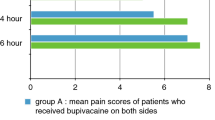Abstract
Tonsillectomy is one of the common surgeries performed by Otorhinolaryngologists and is associated with several morbidities with pain being the commonest, which can cause considerable delay in oral intake and discharge from the hospital. As a commonly performed day care procedure nowadays, pain control is much better than what it used to be previously observed. Therefore newer drugs are being constantly studied inorder to give better analgesia and post operative comfort to the patient with minimal side effects. The main obstacle being finding the best medical method to control pain with minimum side effects, but at the same time making sure that the patient is adequately hydrated and they resume regular eating as soon as possible. Our aim is to study the role of pre-incisional 0.5% bupivacaine versus normal saline infiltration in post-tonsillectomy analgesia. Over a period of 1 year, 30 patients with each group of 15 were compared for the efficacy of 0.5% bupivacaine and 0.9% normal saline in post-operative tonsillectomy pain management. After thorough clinical examination and investigations, all patients underwent tonsillectomy by dissection and snare method. After intubation, 0.5% bupivacaine or normal saline was infiltrated in the tonsillar fossa and pain scores was obtained using Visual Analogue Scale (V.A.S) at 6, 12 and 24 h post operatively. Using Mann–Whitney non-parametric statistical test, inter-group analysis was done which showed highly significant p-value (<0.0001) indicating that the pre-incisional bupivacaine infiltration is highly effective in reducing the post-tonsillectomy pain. Hence, we recommend the routine use of pre-incisional peritonsillar infiltration of 0.5% bupivacaine in all tonsillectomy/adenotonsillectomy cases, irrespective of the age of the patient to reduce the post tonsillectomy pain and other discomfort associated with it.

Similar content being viewed by others
Availability of Data and Material
Not applicable.
Code Availability
Not applicable.
References
Jebeles JA, Reilly JS, Gutierrez JF, Bradley EL, Kissin I (1991) The effect of pre-incisional infiltration of tonsils with bupivacaine on the pain following tonsillectomy under general anesthesia. Pain 47(3):305–308. https://doi.org/10.1016/0304-3959(91)90220-r
Tverskoy M, Cozacov C, Ayache M, Bradley EL, Kissin I (1990) Postoperative pain after inguinal herniorrhaphy with different types of anesthesia. Anesth Analg 70(1):29–35. https://doi.org/10.1213/00000539-199001000-00006
Ejlersen E, Andersen HB, Eliasen K, Mogensen T (1992) A comparison between preincisional and postincisional lidocaine infiltration and postoperative pain. Anesth Analg 74(4):495–498. https://doi.org/10.1213/00000539-199204000-00004
Dahl JB, Brennum J, Arendt-Nielsen L, Jensen TS, Kehlet H (1993) The effect of pre-versus postinjury infiltration with lidocaine on thermal and mechanical hyperalgesia after heat injury to the skin. Pain 53(1):43–51. https://doi.org/10.1016/0304-3959(93)90054-s
Holthusen H, Eichwede F, Stevens M, Willnow U, Lipfert P (1994) Pre-emptive analgesia: comparison of preoperative with postoperative caudal block on postoperative pain in children. Br J Anaesth 73(4):440–442. https://doi.org/10.1093/bja/73.4.440
Assessment-module.yale.edu. n.d. Visual Analogue Scale|Yale Assessment Module Training. [online]. https://assessment-module.yale.edu/im-palliative/visual-analogue-scale. Accessed 20 Sept 2020
Møiniche S, Kehlet H, Dahl JB (2002) A qualitative and quantitative systematic review of preemptive analgesia for postoperative pain relief: the role of timing of analgesia. Anesthesiology 96(3):725–741. https://doi.org/10.1097/00000542-200203000-00032
Bhadoria P, Rathore PK, Mandal S et al (2006) Role of Bupivacaine in reducing post tonsillectomy pain. Indian J Otolaryngol Head Neck Surg 58:335–336. https://doi.org/10.1007/BF03049582
Wong AK, Bissonnette B, Braude BM, Macdonald RM, St-Louis PJ, Fear DW (1995) Post-tonsillectomy infiltration with bupivacaine reduces immediate postoperative pain in children. Can J Anaesth 42(9):770–774. https://doi.org/10.1007/BF03011174
Said E (2009) Preinsional peritonsillar infiltration for postoperative pain relief in children following adenotonsillectomy Placebo-controlled study. Ain Shams J Anesth 2(2):39–52
Gupta AK, Gupta S, Meena DS, Sharma U (2002) Post-tonsillectomy pain: different modes of pain relief. Indian J Otolaryngol Head Neck Surg 54(2):136–139. https://doi.org/10.1007/BF02968733
Bhatia U, Patel KD (2014) Peritonsillar infiltration with 0.25% bupivacaine for preemptive analgesia in paediatric patients undergoing tonsillectomy. NHL J Med Sci 3(1), 12–15
Kountakis SE (2002) Effectiveness of perioperative bupivacaine infiltration in tonsillectomy patients. Am J Otolaryngol 23(2):76–80. https://doi.org/10.1053/ajot.2002.28771
Author information
Authors and Affiliations
Corresponding author
Ethics declarations
Conflicts of interest
The authors declare that they have no conflict of interest.
Ethics Approval
Approval was obtained from the ethics committee of KLE Academy of Higher Education and Research. The procedures used in this study adhere to the tenets of the Declaration of Helsinki.
Consent to Participate
Written informed consent was obtained from the relatives/ legal guardians of the study participant.
Additional information
Publisher's Note
Springer Nature remains neutral with regard to jurisdictional claims in published maps and institutional affiliations.
Rights and permissions
About this article
Cite this article
Ankle, N.R., Yeramalla, V. & Havaldar, R.R. Role of Pre-incisional Bupivacaine Infiltration in Post-tonsillectomy Analgesia. Indian J Otolaryngol Head Neck Surg 74 (Suppl 3), 5296–5300 (2022). https://doi.org/10.1007/s12070-020-02252-7
Received:
Accepted:
Published:
Issue Date:
DOI: https://doi.org/10.1007/s12070-020-02252-7




